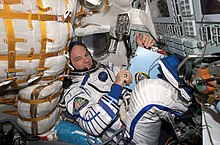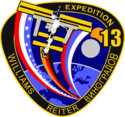Jeffrey Williams
| Jeffrey Nels Williams | |
|---|---|
 | |
| Astronaut NASA | |
| Státní příslušnost | USA |
| Datum narození | 18. ledna 1958 (64 let) |
| Místo narození | Superior, Wisconsin, USA |
| Předchozí zaměstnání | Letec Armády USA |
| Čas ve vesmíru | 534 dní, 2 hodiny a 49 minuty |
| Kosmonaut od | 1. května 1996 |
| Mise | STS-101; Expedice 13 (Sojuz TMA-8/ISS); Expedice 21/22 (Sojuz TMA-16/ISS); Expedice 47/48 (Sojuz TMA-20M/ISS). |
| Znaky misí | |
| Kosmonaut do | dosud aktivní |
| Některá data mohou pocházet z datové položky. | |
Jeffrey Nels Williams (* 18. ledna 1958 v Superior, ve státě Wisconsin, USA) je od května 1996 americký astronaut, člen oddílu astronautů NASA. Ve vesmíru strávil během svých čtyř letů necelých 534 dní se kterými drží současný americký rekord, v celkovém počtu dní strávených v kosmu.[1] Williams se poprvé do vesmíru podíval v roce 2000 na palubě raketoplánu Atlantis. Poté v roce 2006, kdy letěl jako palubní inženýr na Mezinárodní vesmírnou stanici v rámci Expedice 16. Půlroční směnu na ISS si zopakoval ještě dvakrát, v letech 2009–2010, v Expedici 21/22 a v roce 2016 v Expedici 47/48. V Expedicích 22 a 48 působil jako velitel.
Život
Voják
Jeffrey Williams se narodil v Superior ve Wisconsinu, dětství prožil ve městě Winter v témže státu, zde také roku 1976 ukončil střední školu. Roku 1980 získal bakalářský titul na Vojenské akademii (U.S. Military Academy). Poté sloužil v armádě, v letech 1981–84 v Německu. Roku 1987 získal magisterský titul na U.S. Naval Postgraduate School. Potom do roku 1991 pracoval v Johnsonovu vesmírném středisku. V letech 1992–93 se učil ve škole zkušebních letců námořnictva (Naval Test Pilot School), následující dva roky strávil na Edwardsově letecké základně.[2]
Astronaut
Přihlásil se do 12. náboru astronautů NASA roku 1987, kdy se pouze dostal mezi 117 finalistů. Roku 1991 se zúčastnil 14. náboru, ale zase neprošel. Úspěch slavil až napotřetí, v květnu 1996 v 16. náboru. Absolvoval dvouletou všeobecnou kosmickou přípravu a získal kvalifikaci letový specialista.[2]
Záhy po skončení základního výcviku, v listopadu 1998 byl zařazen do posádky letu STS-101. Do vesmíru odstartoval na palubě raketoplánu Atlantis 19. května 2000. Během mise vystoupil do otevřeného vesmíru, výstup trval 6 hodin 44 minut. Raketoplán přistál po 9 dnech, 20 hodinách a 10 minutách letu dne 29. května 2000.[3]
V listopadu 2002 byl jmenován velitelem záložní posádky Expedice 10 na Mezinárodní vesmírnou stanici (ISS), ale už v únoru 2003 byla posádka rozpuštěna. Znovu zahájil přípravu na pobyt na ISS v prosinci 2003, kdy se stal velitelem záložní posádky Expedice 12 (startovala v říjnu 2005) a hlavní posádky Expedice 14 (startovala v září 2006). V září 2005 nahradil Daniela Taniho, palubního inženýra Expedice 13, do kosmu se tak dostal o půl roku dříve.[2]

Podruhé vzlétl do vesmíru 30. března 2006 v ruském Sojuzu TMA-8. Na ISS pracoval společně s Rusem Pavlem Vinogradovem a od července 2006 i Němcem Thomasem Reiterem. Uskutečnil dva výstupy do vesmíru o celkové délce 12 hodin a 25 minut. Dvojice Williams, Vinogradov přistála 29. září 2006 po 182 dnech, 22 hodinách a 43 minutách letu.[4]
V srpnu 2007 byl předběžně zařazen do Expedice 21 (start plánován na říjen 2009), v září (resp. listopadu) 2008 bylo jmenování oficiálně potvrzeno Roskosmosem (resp. NASA). Paralelně od července 2008 působil v záložní posádce Expedice 19 (start v březnu 2009).[2]
Potřetí do kosmu odstartoval 30. září 2009 na palubě lodi Sojuz TMA-16 společně s kolegou z Expedice 21 Maximem Surajevem a kosmickým turistou Guyem Laliberté. Po obvyklém dvoudenním letu se Sojuz spojil s ISS.[5] Laliberé se po týdnu vrátil s vystřídanými členy Expedice 20 na Zem, Williams a Surajev zůstali na stanici do března 2010. Dne 18. března 2010 Surajev s Williamsem v Sojuzu TMA-16 přistáli v Kazachstánu.[2][5]
V lednu 2014 byl jmenován členem Expedice 47/48 se startem v březnu 2016 v Sojuzu TMA-20M, do posádky s ním byli zařazeni Alexej Ovčinin a Oleg Skripočka.[2] V únoru 2014 jmenování potvrdila NASA.[6] Paralelně byl náhradníkem Scotta Kellyho v Sojuzu TMA-16M (start v březnu 2015).[2] V listopadu 2015 byl Sojuz MS-01 zaměněn za Sojuz TMA-20M.[7]
Trojice Ovčinin, Skripočka, Wiliams vzlétla k ISS 18. března 2016. Na stanici pracoval ve funkci palubního inženýra Expedice 47 a velitele Expedice 48. Během letu provedl s Kathleen Rubinsovou dva výstupy do otevřeného vesmíru o celkové délce 12 hodin a 46 minut. Po necelých šesti měsících se 7. září 2016 ve stejné sestavě posádka Sojuzu TMA-20M vrátila na Zem. Jejich let trval 172 dní, 3 hodiny, 47 minut a 15 sekund.[2]
Reference
- ↑ Record-Breaking Astronaut Jeff Williams Congratulated By Scott Kelly [online]. [cit. 2016-10-20]. Dostupné online.
- ↑ a b c d e f g h IVANOV, Ivan, a kol. Космическая энциклопедия ASTROnote [online]. Moskva: rev. 2008-12-12 [cit. 2009-08-08]. Kapitola Nicole Passonno Stott. Dostupné online. (rusky)
- ↑ HOLUB, Aleš. MEK. Malá encyklopedie kosmonautiky [online]. Rev. 2000-06-05 [cit. 2009-08-14]. Kapitola STS-101 At/F-21. [dále jen Holub]. Dostupné online.
- ↑ Holub. Rev. 2006-12-12 [cit. 2009-08-14]. Kapitola Expedice 13.
- ↑ a b Holub. Rev. 2009-09-30 [cit. 2009-09-30]. Kapitola Sojuz TMA-16.
- ↑ BUCK, Joshua; BOLDEN, Jay. Press release 14-048: NASA, International Space Station Partners Announce Future Crew Members [online]. NASA, 2014-2-11 [cit. 2015-06-20]. Dostupné online. (anglicky)
- ↑ Ivanov. Rev. 2015-11-6 [cit. 2016-01-10]. Kapitola Хроника подготовки и полёта корабля «Союз ТМА-20М» (ISS-46S).
Externí odkazy
 Obrázky, zvuky či videa k tématu Jeffrey Nels Williams na Wikimedia Commons
Obrázky, zvuky či videa k tématu Jeffrey Nels Williams na Wikimedia Commons - Biographical data. Jeffrey N. Williams [online]. NASA, rev. 2009-01 [cit. 2009-08-14]. Dostupné v archivu pořízeném dne 2009-08-25. (anglicky) – Oficiální biografie NASA
Média použitá na této stránce
ISS013-E-60772 (26 July 2006) --- Attired in a Russian Sokol launch and entry suit, astronaut Jeffrey N. Williams, Expedition 13 NASA space station science officer and flight engineer, is photographed in the TMA-8 Soyuz spacecraft docked to the International Space Station.
Expedition 21 will be the 21st long duration mission on-board the International Space Station (ISS) and the second to include six crew members.
- The central element of the patch is inspired by a fractal of six, symbolizing the teamwork of the six-person crew. From the basic element of one person, together six people form a much more complex and multifaceted entity, toward the infinity of the universe. The patch shows children, on Earth in the bright Sun, as our future and the reason we explore. The Soyuz and Shuttle are the vehicles that enable human space exploration today, while the International Space Station is leading to our next goals, the moon and Mars. The patch shape has six tips, geometrically sound yet reminiscent of a leaf, representing symmetry and ecological harmony, while the six stars in deep space represent the current crew and future exploration crews.
ISS Expedition 47 Insignia
- The central depiction of the International Space Station (ISS) is in recognition of the international achievement of designing, building and maintaining a world-class space laboratory. The orientation of the ISS represents the view seen by the Soyuz crewmembers as they approach the station. The blackness of space in the background portrays the limitless area that humankind has yet to explore.
- The efforts of the Expedition 47 crew will contribute to the growing body of knowledge and expertise that will allow us to extend human exploration beyond low-Earth orbit. The three blue colors are from the flags of the Expedition 47 crew’s home countries (United States, Russia and the United Kingdom), representing a fundamental commonality among each of the international partner countries whom the crewmembers serve.
The STS-101 mission patch commemorates the third Space Shuttle flight supporting the assembly of the International Space Station (ISS). This flight's primary tasks are to outfit the ISS and extend its lifetime, and to conduct a spacewalk to install external components in preparation for the docking of the Russian Service Module, Zvezda, and the arrival of the first ISS crew. The Space Shuttle is depicted in an orbit configuration prior to docking with the ISS. The ISS is depicted in the stage of assembly completed for the STS-101 mission, which consists of the United States-built Unity module and the Russian-built Zarya module. The three large stars represent the third ISS mission in the assembly sequence. The elements and colors of the border reflect the flags of the nations represented by the STS-101 crew members, the United States and Russia. The NASA insignia design for Shuttle flights is reserved for use by the astronauts and for other official use as the NASA Administrator may authorize. Public availability has been approved only in the form of illustrations by the various news media. When and if there is any change in this policy, which is not anticipated, it will be publicly announced.
The 22nd Expedition to the International Space Station is dedicated to the final stages of assembly and the transition to full utilization as an orbiting laboratory. The sun, providing power and life support to the space station, shines through one of the solar arrays as the ISS orbits above Earth. The oceans and atmosphere, providing life support to Earth, are shown in all their beauty. The moon hovers in the distance as the goal of the next era of exploration. The six stars illustrate the increased capability of the crew complement. In the border are the national flags of the crew members as well as their surnames in their native languages. Expedition XXII continues the effort to acquire the knowledge necessary to extend the reach of exploration from Earth, to the moon and beyond.
The Expedition 48 crew insignia
- The 48th Expedition to the International Space Station (ISS) marks nearly 16 years of continuous human presence at the orbital outpost. The elements of the crew patch include ISS solar arrays illuminated by the setting sun, the Earth’s horizon at sunset, the Moon, and stars. The simple portrayal of the unique vantage point signifies the incremental contribution of a single international expedition off the planet to the larger endeavor of human space exploration and discovery.
Mission patch of ISS Expedition 13, showing the ISS's configuration at the start of the six-month long mission and trailing flags of the USA, Russia and Germany, representing the three crew members aboard.







